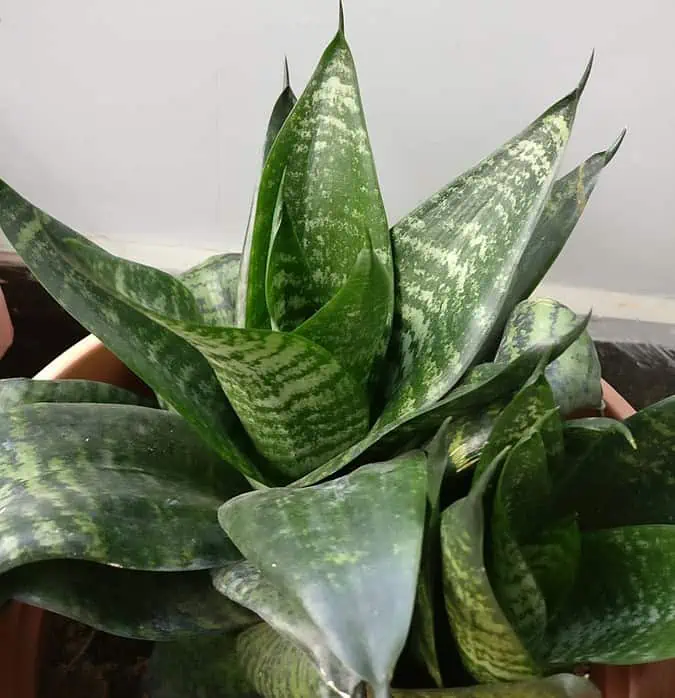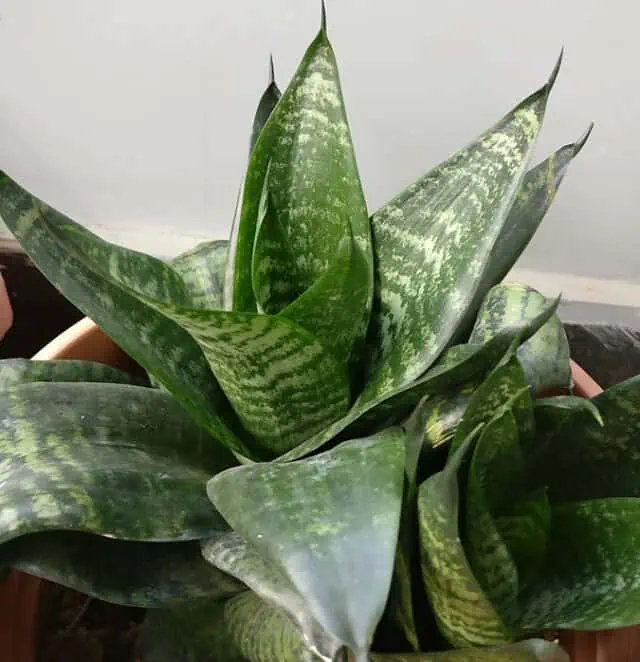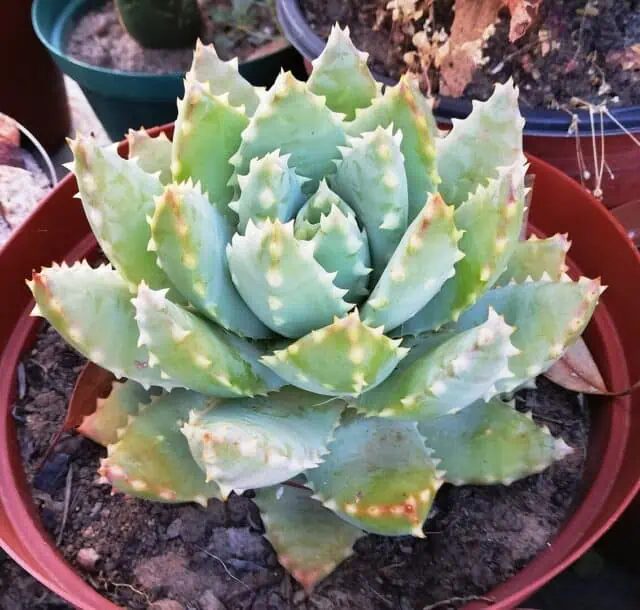Yes, snake plants are safe for leopard geckos, and they’re a popular option for use in their tanks. Often chosen for their hardy and low-maintenance nature, snake plants provide several benefits for these reptiles. While they are safe for ingestion by leopard geckos, their tough texture makes it unlikely for the geckos to chew on them.
However, it’s essential to ensure that the leaves don’t block heat lamps in the enclosure, as this could affect the temperature and overall health of the gecko. With proper placement and care, snake plants can be an excellent addition to your leopard gecko’s habitat.
Safety First: Snake plants are safe for leopard geckos. However, ensure the plant’s leaves don’t block heat lamps, which are crucial for the gecko’s health.
Plant Benefits: Beyond aesthetics, snake plants offer air purification in the tank, releasing oxygen during the gecko’s active hours at night.
Tall Tank Advantage: Snake plants can grow several feet tall, making them ideal for tall leopard gecko tanks. Their height provides vertical interest and climbing opportunities.
Placement Flexibility: Due to their temperature tolerance, snake plants can thrive in various spots within the tank, whether exposed to cooler or warmer areas.
Alternative Options: While snake plants are beneficial, consider other hardy real plants like ZZ plants or aloe vera. Also, enhance the tank’s natural feel with habitat items like rocks and hides.
Are Snake Plants Safe for Leopard Geckos?
When it comes to setting up a habitat for leopard geckos, many owners wonder about the types of plants they can introduce. Snake plants stand out as a popular choice. They are indeed safe for leopard geckos. These plants have a tough texture, which means that even if a gecko tries to ingest them, they are unlikely to cause harm.
However, while they are safe, there’s one significant aspect to keep in mind. The leaves of the snake plant can sometimes grow tall and dense. If placed improperly, they might block heat lamps in the gecko’s tank. It’s vital to ensure that the warmth, crucial for the leopard gecko’s health, is not obstructed by the plant’s foliage.
What is a Snake Plant?
The snake plant, known for its unique appearance, is a common houseplant loved by many. Characterized by its tall, upright leaves with green, wavy patterns, it adds a touch of nature to any setting. One of its standout features is its hardiness. This plant is notably robust and low-maintenance, making it a favorite among both novice and seasoned plant enthusiasts.
Furthermore, snake plants have the ability to tolerate different light conditions, from low light to direct sunlight. This adaptability means they can thrive in various environments, making them suitable for different spaces in a home or an office. For leopard gecko tanks, two species of snake plants are commonly recommended due to their size and appearance.
Benefits of Snake Plants in Leopard Gecko Tanks
Incorporating snake plants into leopard gecko tanks brings a host of advantages. Beyond their aesthetic appeal, these plants offer functional benefits that enhance the overall environment of the tank.
Hardiness
One of the standout attributes of the snake plant is its hardiness. This resilience makes it a prime choice for leopard gecko tanks. Snake plants are adept at handling environmental fluctuations, be it in humidity or temperature. Their robust nature allows them to tolerate a wide range of temperature conditions. Whether the tank experiences warm or cool temperatures, the snake plant remains unfazed.
Air Purification
The snake plant is more than just a decorative addition to leopard gecko tanks; it plays a pivotal role in air purification. These plants are renowned for their capacity to filter out toxins and pollutants from the surroundings. By removing harmful substances, snake plants contribute to creating a healthier environment for the geckos.
Another unique characteristic of the snake plant is its ability to release oxygen during the night. While most plants undergo photosynthesis during the day, snake plants continue this process at night. This nocturnal oxygen release aligns perfectly with the gecko’s active hours, ensuring a fresh supply of air when they are most active.
Great For Tall Tanks
For those with tall tanks designed for leopard geckos, the snake plant emerges as an excellent choice. These plants have the potential to grow several feet tall, introducing a captivating vertical interest to the enclosure. By utilizing the vertical space effectively, snake plants can transform a plain tank into a dynamic and layered habitat.
Their height not only adds aesthetic value but also creates an enriched environment for the geckos. The upright leaves and stems of the snake plant can serve as structures for leopard geckos to explore and climb, encouraging their natural behaviors and offering them a more engaging and interactive space.
Flexible Placement Options
The snake plant’s adaptability to different temperatures grants it a unique advantage when considering placement within leopard gecko tanks. This plant’s inherent temperature flexibility means that it isn’t overly sensitive to the tank’s heat gradients.
Whether exposed to cooler or warmer temperatures, the snake plant remains resilient and continues to flourish. Such adaptability simplifies the process of finding the ideal spot for the plant in the enclosure.
Owners don’t need to be overly concerned about the exact placement, providing a hassle-free experience while ensuring the tank remains aesthetically pleasing and beneficial for the gecko.
Alternatives to Snake Plants In Leopard Gecko Tanks
While snake plants offer numerous advantages for leopard gecko habitats, it’s worth exploring other options to diversify and cater to specific needs. Whether you’re looking for similar benefits or different aesthetics, several alternatives can complement or even replace snake plants in the enclosure.
Artificial Plants
Artificial plants have found their way into many leopard gecko tanks, and for good reasons. Firstly, they are low-maintenance, eliminating the need for watering, soil changes, or light adjustments. Their durability ensures they are long-lasting, and when it comes to cleaning, they are notably easy to clean, making tank maintenance a breeze.
However, while they offer these conveniences, they do come with some trade-offs. Unlike live plants, artificial ones don’t aid in air purification or humidity regulation. Additionally, while they can mimic the appearance of real plants, they might not fully capture the naturalistic aesthetics that live plants bring to the habitat.
Other Hardy Real Plants
In the realm of leopard gecko tanks, aside from snake plants, there are other hardy real plants that can thrive and offer a range of benefits. Plants like the ZZ plant, haworthia, and aloe vera are examples that have gained popularity among gecko enthusiasts. The same goes for other succulent plants. Air plants have an advantage in their ability to thrive with little water.
These plants, similar to the snake plant, are known for their low-maintenance nature. They can effortlessly adapt to cooler temperatures and various indoor conditions, making them a suitable choice for those who want to maintain a natural environment without the added upkeep.
These hardy plants also possess air-purifying qualities, ensuring a clean and fresh atmosphere for the geckos.
Natural Habitat Items
Beyond plants, natural habitat items play a significant role in leopard gecko tanks. These elements, derived from nature, bring authenticity to the enclosure, making it resemble the gecko’s wild environment.
Incorporating items like rocks, branches, and hides not only enhances the enclosure aesthetically but also provides practical benefits. A realistic environment ensures the gecko feels at home, promoting natural behaviors and contributing to their overall well-being.
Rocks can serve as basking spots, while branches offer climbing opportunities. Hides, on the other hand, provide a private space for the gecko to retreat and feel secure.
By strategically placing these items within the tank, one can create various hiding spots and activity zones, ensuring the gecko has a comfortable environment with ample opportunities for exploration and relaxation.







